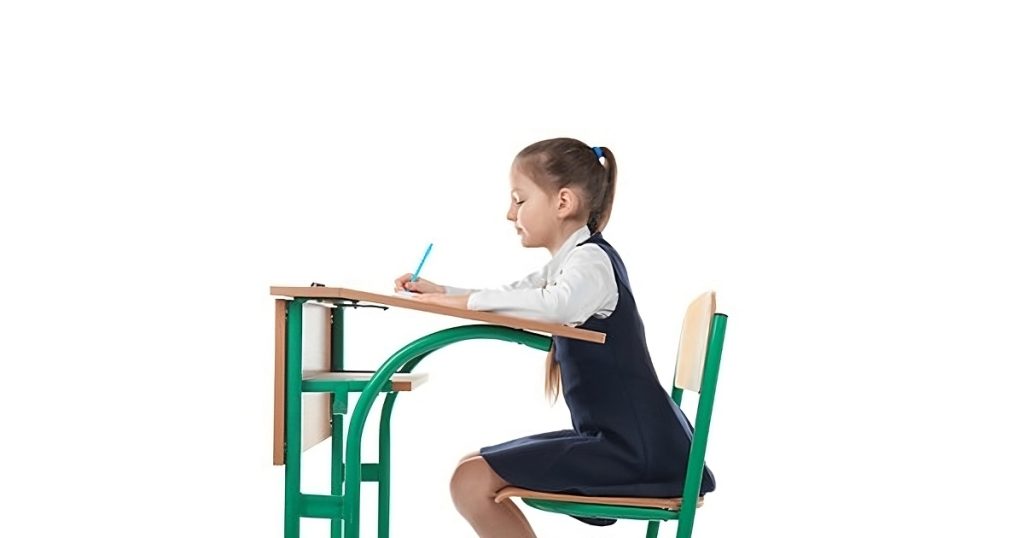In the classroom seating, sitting with incorrect posture can quickly tire us, strain our neck and back, and hinder our ability to concentrate and feel comfortable. Maintaining good posture means arranging the bones in our back so that our body feels calm and attentive. Imagine doing the opposite of what many of us do when we sit at a table or desk.
Often, students lean forward and squeeze their shoulder blades together, especially when reading or sitting at their work desk. Nowadays, students aren’t as physically active as they used to be, and they tend to slouch more.
Because of this, their core muscles, which are important for strength, are usually not getting the exercise they require.
Why is posture important for students?

The connection between mind and body is crucial. It demonstrates how our thoughts and feelings can impact our physical well-being, and vice versa. Having good posture means keeping your body in a proper and upright position, where the spine is aligned well.
This helps prevent strain and tension in the muscles and ligaments, which can cause pain and tiredness. While many students struggle with learning due to school-related challenges, we often forget to think about how important posture is for them.
Does posture affect learning?
Practicing good posture can have positive effects on students.
It can help improve their thinking abilities, especially their ability to concentrate, and their overall mood. Slouching can lead to feeling tired, daydreaming, and experiencing muscle discomfort.
Moreover, looking down at your desk may actually be a consequence of poor posture. It can result from fatigue caused by muscle soreness and the tendency to feel sleepy while slouching.
Maintaining a proper posture is beneficial for staying focused because it enables students to actively observe the lesson being taught. It’s also crucial for students to sit with good posture when they’re writing. This means sitting up straight and paying attention to how they hold their pencil.
Importance of chairs in classroom seating
Educational institutions regularly update their curriculum and teaching methods to meet new education standards. However, they often overlook the importance of physical convenience in their classrooms. It appears that classroom furniture has an important job in deciding how much and how effectively a child learns.
Seating arrangements should be done in a manner that allows students to be comfortable. All of these factors greatly influence students’ learning experiences and can significantly enhance their performance if addressed properly.
It is important for classroom furniture to be suitable for children, allowing them to move comfortably and maintain good posture. Currently, about 83% of students use desks and chairs that aren’t suitable for their height.
Even though they are in the same age group, their physical growth varies, so one standard desk or bench may not be suitable for everyone. Poorly designed classroom furniture can lead to body pain, especially in the back and neck, which can be distracting for students and hinder their concentration in class.
By selecting the appropriate school furniture, educators can make sure that students can focus better. This greatly enhances their performance and helps them achieve success.

Best classroom seating arrangements
It’s not surprising to learn that where students sit in class can affect how well they learn.
For instance, educators observe that students who sit in the front rows are usually more focused. They are also more attentive compared to those in the back, and are likely to ask questions and actively participate in class.
Spaces that are created with students in mind, with a focus on how they learn and work together, can help students learn better. However, many classrooms in colleges and universities are designed using traditional models for lectures and seminars.
Below are a few seating methods that educators can use for a better learning experience for their students:
- Traditional: The typical way an educator gives a lecture is by having rows of fixed seats in the classroom.
The students face the educator but not each other. Usually, the students in the front or middle rows have the most interaction with the educator, while those in the back rows tend to be less involved.
- Horseshoe: The horseshoe or semicircle setup is like a modified roundtable. All participants face each other, and the educator can move around the room. This arrangement encourages discussions between students and with the educator. The horseshoe is useful when the educator wants to show and discuss materials at the front of the class.
- Roundtable: In some classes, the room is set up like a seminar with a big table in the center. This arrangement allows everyone to face each other, which makes it easier to have whole-class discussions and talk in pairs.
- Pods: The pod or pair arrangement can have rectangular, circular, or trapezoidal tables, or individual desks. The educator can group several tables together to create small groups of students (usually 3-4 students) or pairs. This setup is especially useful when students need to work in groups or pairs for a significant part of the class.
In a nutshell
Classroom posture plays a significant role in the overall learning experience and academic performance of students.
The way students sit and position themselves in the classroom can affect their attention, concentration, and cognitive functioning.
Additionally, incorporating ergonomic furniture such as adjustable chairs and desks in the classroom can provide students with the flexibility to find comfortable and supportive positions that promote good posture. Creating a layout that allows for movement and encourages active learning can also help in preventing prolonged static postures and encourage students to change positions regularly.
To explore ways in which we can make classrooms a safe and comfortable environment for our students, we invite you to check out our EDU Blog.







